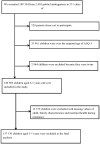Association of Gestational Age at Birth With Subsequent Neurodevelopment in Early Childhood: A National Retrospective Cohort Study in China
- PMID: 35712637
- PMCID: PMC9194570
- DOI: 10.3389/fped.2022.860192
Association of Gestational Age at Birth With Subsequent Neurodevelopment in Early Childhood: A National Retrospective Cohort Study in China
Abstract
Background: The association between preterm birth and neurodevelopmental delays have been well examined, however, reliable estimates for the full range of gestational age (GA) are limited, and few studies explored the impact of post-term birth on child development.
Objective: This study aimed to examine the long-term neuropsychological outcomes of children born in a full range of GA with a national representative sample in China.
Methods: In this retrospective population-based cohort study, a total of 137,530 preschoolers aged 3-5 years old (65,295/47.5% females and 72,235/52.5% males) were included in the final analysis. The Ages and Stages Questionnaires-Third Edition (ASQ-3) was completed by parents to evaluate children's neurodevelopment. The associations between GA and neurodevelopment were analyzed by a generalized additive mixed model with thin plate regression splines. Logistic regression was also conducted to examine the differences in children's development with different GAs.
Results: There was a non-linear relationship between GA and children's neurodevelopmental outcomes with the highest scores at 40 weeks gestational age. The adjusted risks of GAs (very and moderately preterm, late-preterm, early-term, and post-term groups) on suspected developmental delays were observed in communication (OR were 1.83, 1.28, 1.13, and 1.21 respectively, each p < 0.05), gross motor skill (OR were 1.67, 1.38, 1.10, and 1.05 respectively, each p < 0.05), and personal social behavior (OR were 1.01, 1.36, 1.12, and 1.18 respectively, each p < 0.05). The adjusted OR of very and moderately preterm, late-preterm, and early-term were observed in fine motor skills (OR were 1.53, 1.22, and 1.09 respectively, each p < 0.05) and problem-solving (OR were 1.33, 1.12, and 1.06 respectively, each p < 0.05).
Conclusion: GAs is a risk factor for neurodevelopmental delays in preschoolers after controlling for a wide range of covariates, and 40-41 weeks may be the ideal delivery GA for optimal neurodevelopmental outcomes. Close observation and monitoring should be considered for early- and post-term born children as well as pre-term children.
Keywords: early and post-term delivery; early childhood; gestational age; national representative sample; neurodevelopment.
Copyright © 2022 Hua, Barnett, Lin, Guan, Sun, Williams, Fu, Zhou and Du.
Conflict of interest statement
The authors declare that the research was conducted in the absence of any commercial or financial relationships that could be construed as a potential conflict of interest.
Figures



References
-
- WHO . ICD-11 for Mortality and Morbidity Statistics. Available online at: https://icd.who.int/browse11/lm/en/http%3a%2f%2fid.who.int%2ficd%2fentit.... (2020).
-
- American Psychiatric Association APADasmomdD-US . Diagnostic and Statistical Manual of Mental Disorders. 5th ed. Washington DC: American Psychiatric Association; (2013). 10.1176/appi.books.9780890425596 - DOI
-
- Melillo R, Leisman G. Neurobehavioral Disorders of Childhood: An Evolutionary Perspective. Springer Science & Business Media. (2004).
-
- Accardo PJ, Capute AJ. Capute & Accardo's Neurodevelopmental Disabilities in Infancy and Childhood. 3rd ed Baltimore: Paul H Brookes Pub. (2008).
LinkOut - more resources
Full Text Sources

